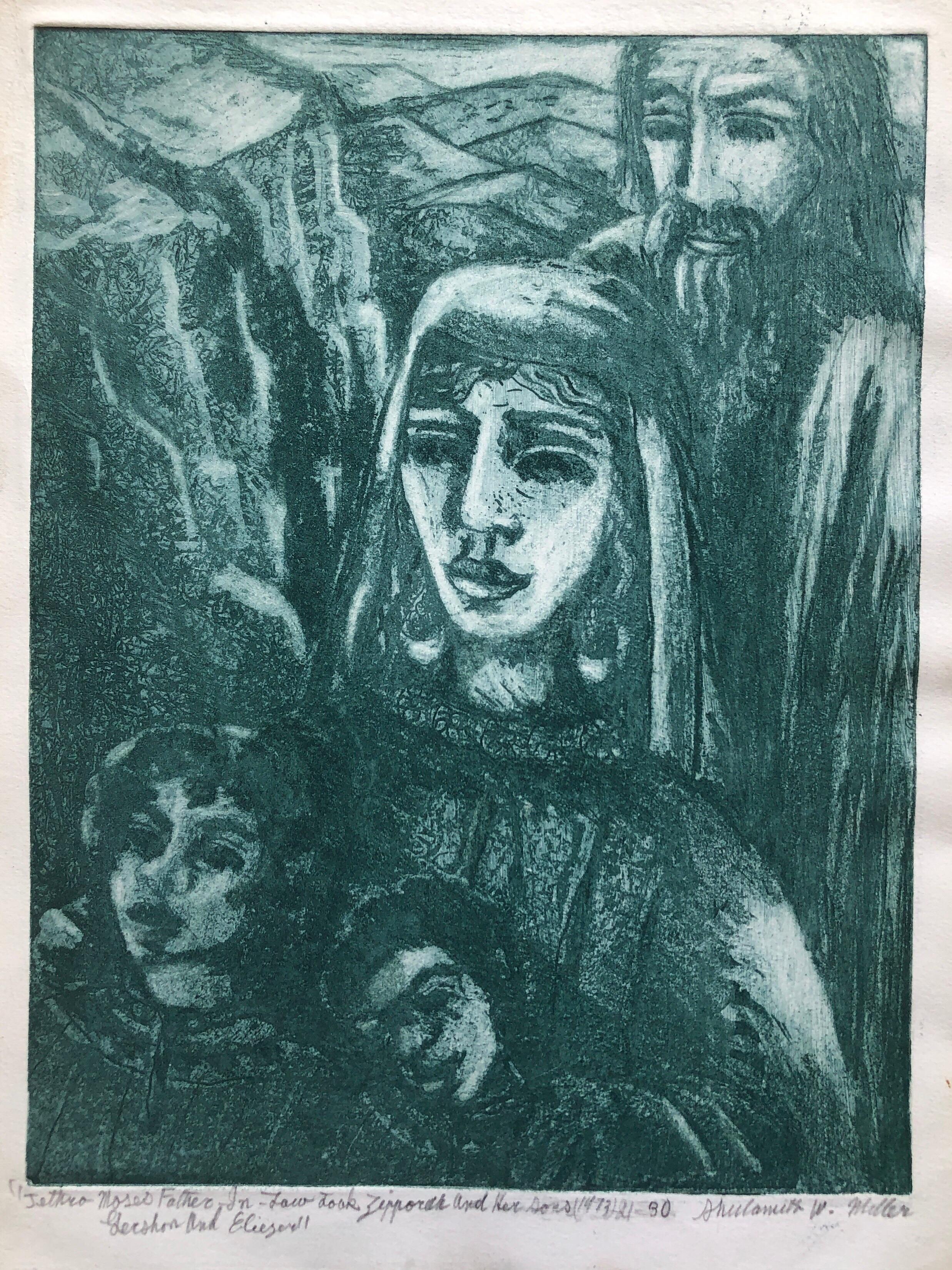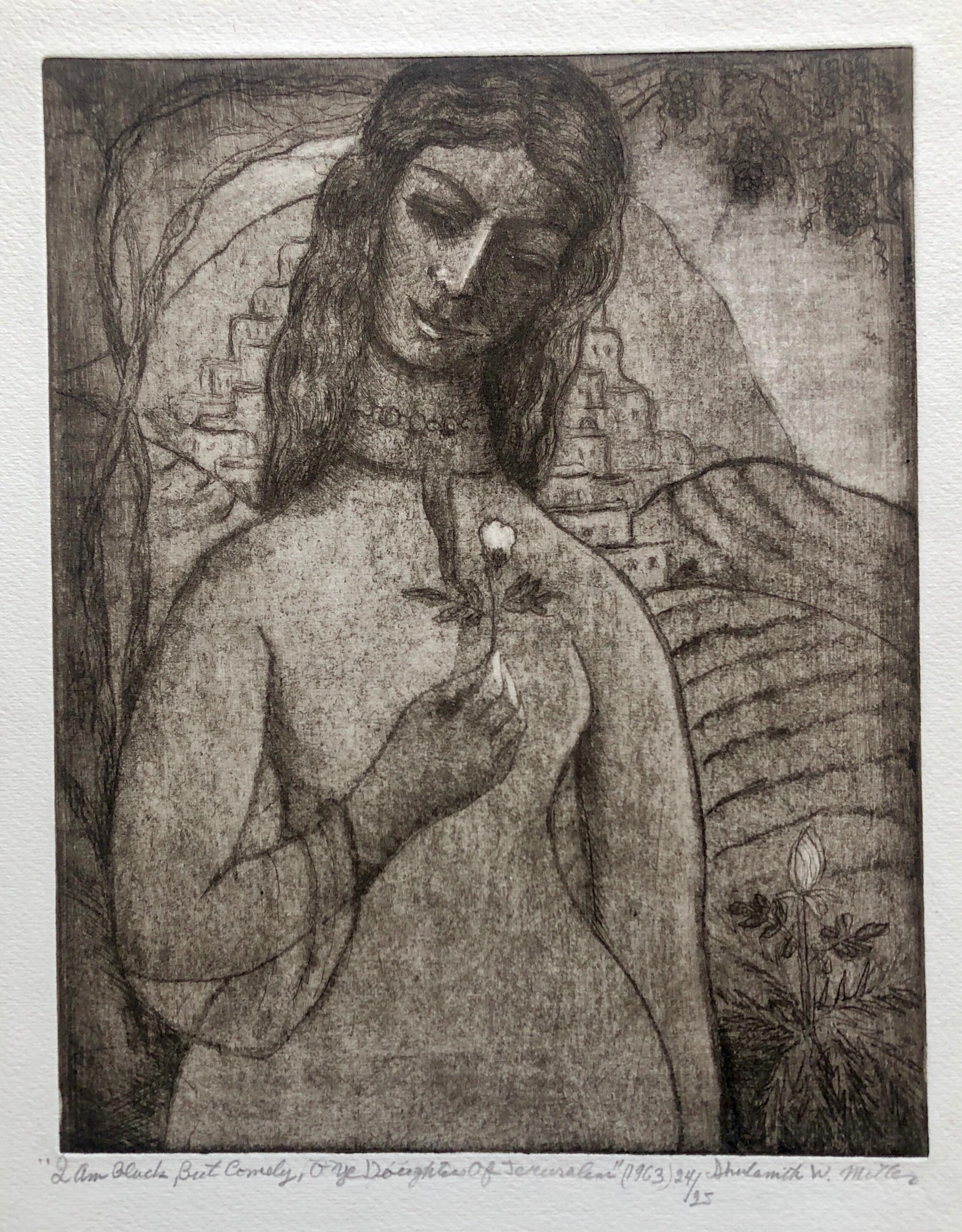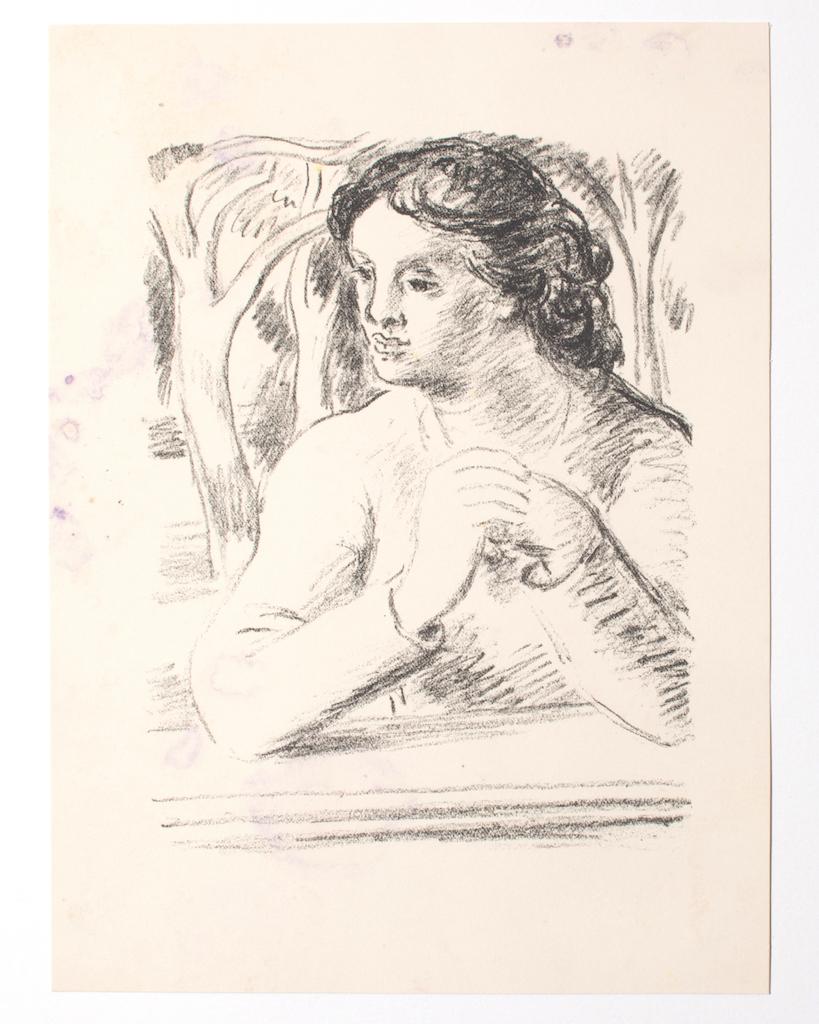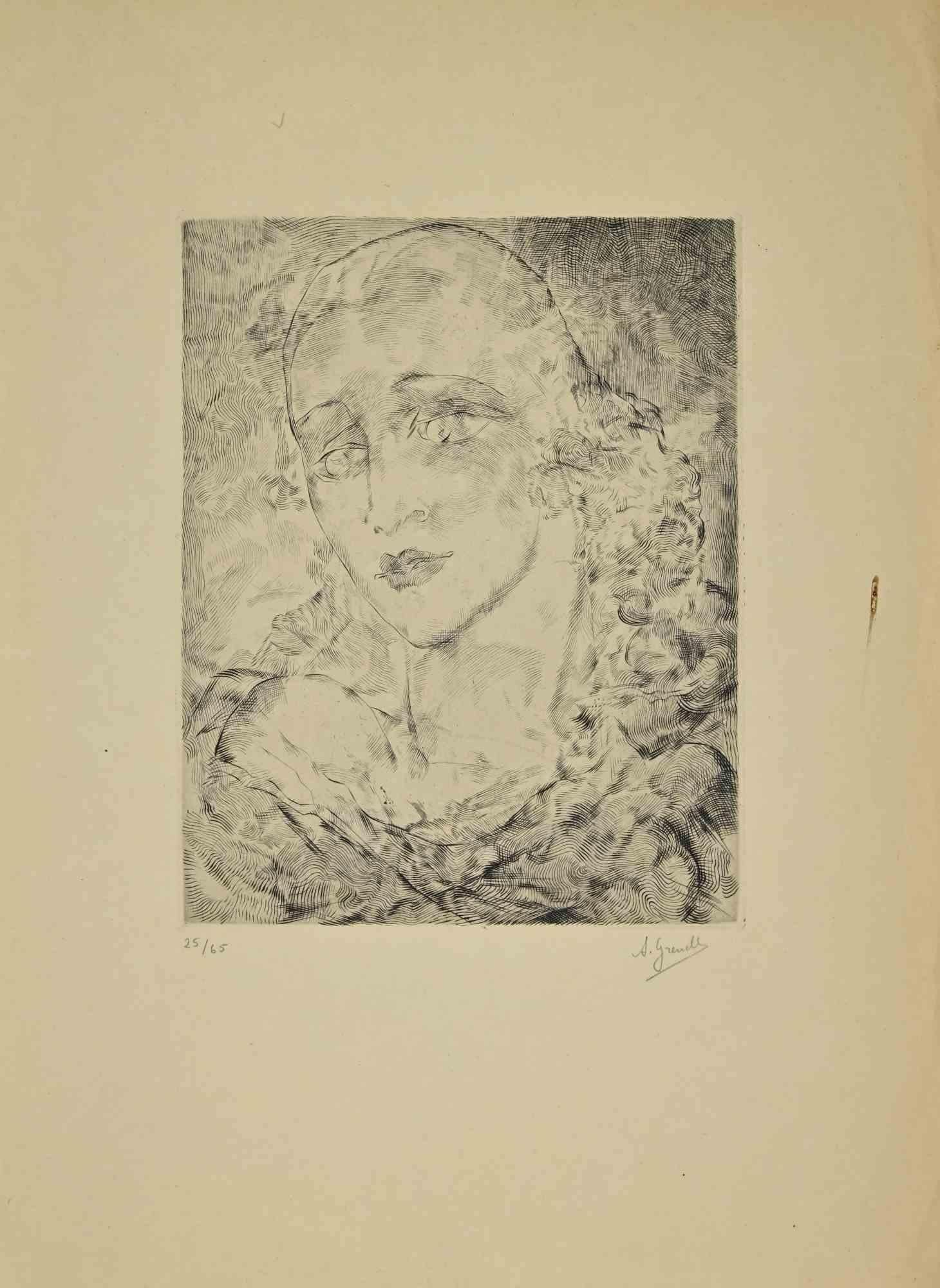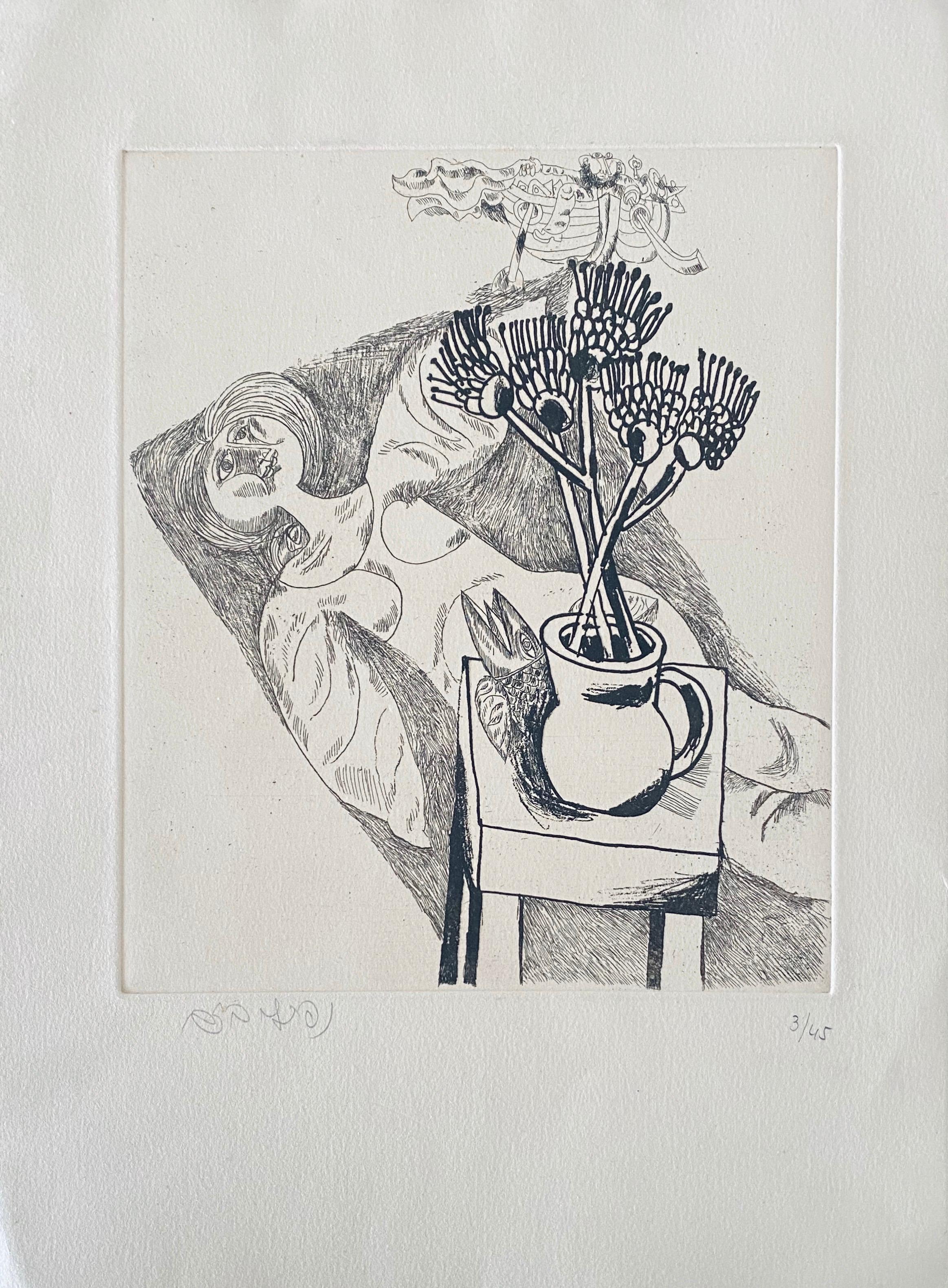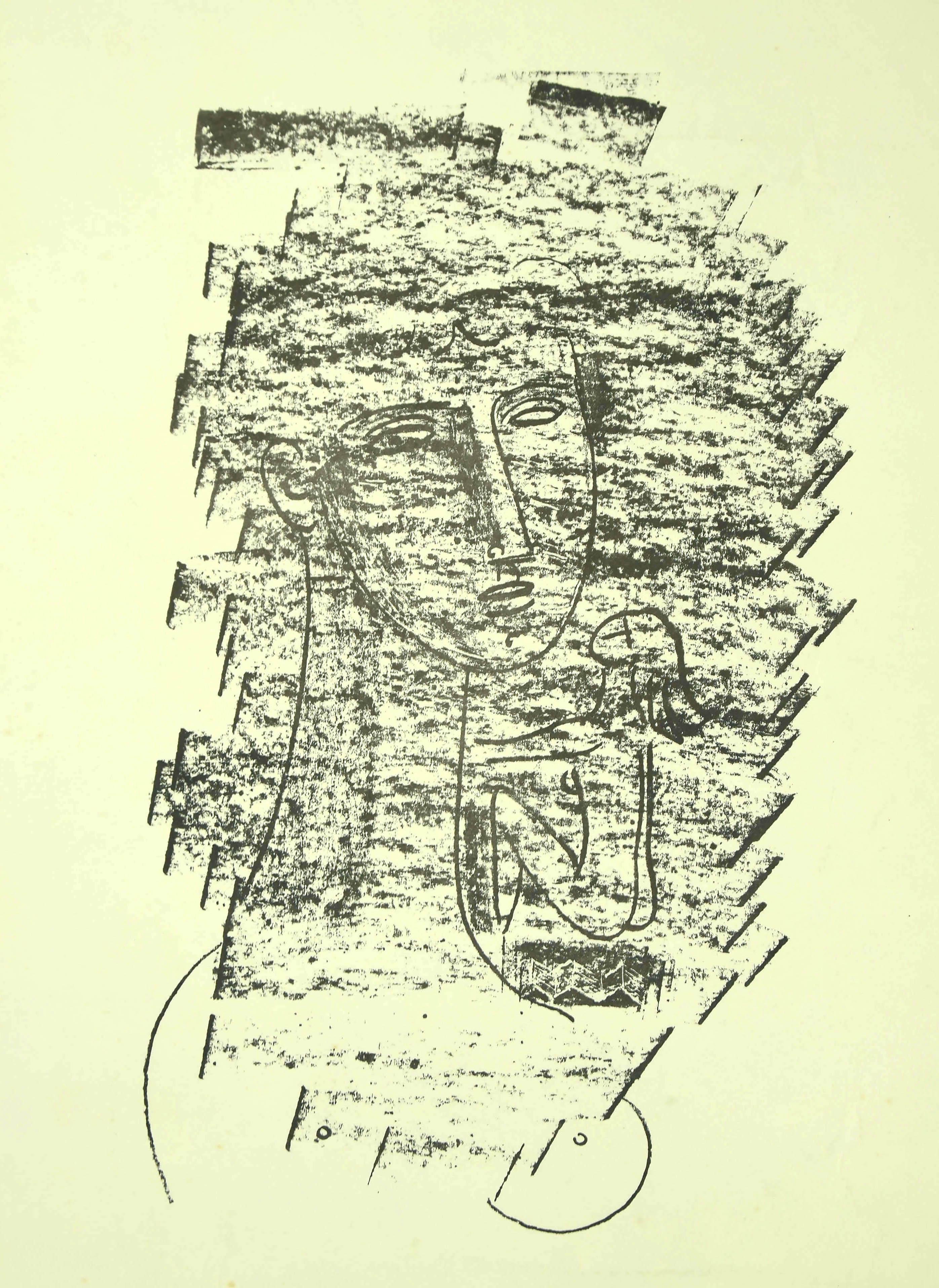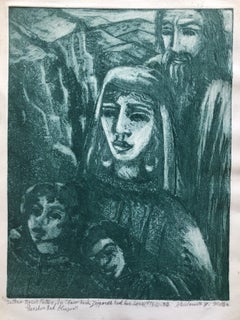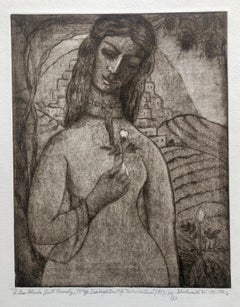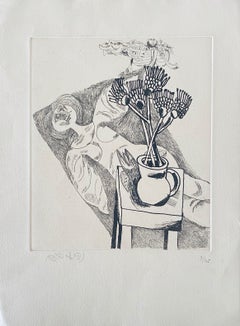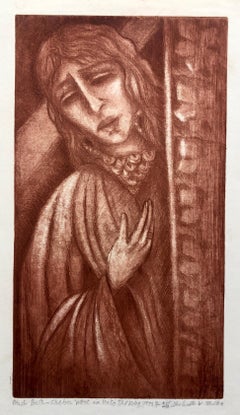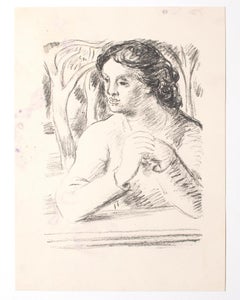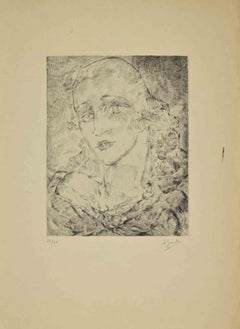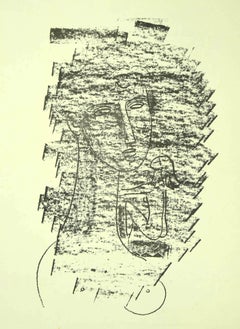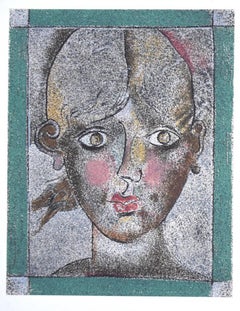Items Similar to Early Israeli Russian Artist Lithograph With Woman Bezalel
Want more images or videos?
Request additional images or videos from the seller
1 of 7
Miriam HadgadyaEarly Israeli Russian Artist Lithograph With Woman Bezalel1932
1932
$500
£371.92
€435.44
CA$697.67
A$780.71
CHF 407.65
MX$9,598.04
NOK 5,142.99
SEK 4,839.53
DKK 3,248.71
Shipping
Retrieving quote...The 1stDibs Promise:
Authenticity Guarantee,
Money-Back Guarantee,
24-Hour Cancellation
About the Item
All but forgotten today, Had Gadya was the first woman to study at the Bezalel Art School and an outstanding painter in 1920s' Tel Aviv.
In 1912, she was 17 years old, the only female student at Bezalel. She had just come from Russia, and had been given the curious nickname "Had Gadya."
During her first year at Bezalel, the artist and teacher Shmuel Levy Ophel painted a wonderful portrait of Had Gadya, a girl-woman, in shades of dusky blue. Her expression was both innocent and arousing - her trademark.
In the 1920s, Had Gadya was the face of Bezalel. A kind of muse, a boyish nymph. She appears in a number of photographs by Yaakov Ben Dov, who documented life at Bezalel in the early years.
But Had Gadya was more than a pretty face. She was a talented painter, according to the chief curator of the Israel Museum, Yigal Zalmona.
In contrast, art historian Gideon Ofrat believes that her "spirit hovers over the complex and legendary beginnings of Bezalel and Boris Schatz and that is all."
Had Gadya's real name was Marousia (Miriam) Nissenholtz. She was born in Russia in 1895 in a small town called Kodama, near Odessa. Both her parents were pharmacists.
The most significant event in her life was without a doubt the Bezalel exhibition in Odessa. On Passover in 1911, Boris Schatz came to display works created at Bezalel and to enlist new students and funding for the institution, which was then barely surviving. It was still very cold when the big white tent went up in Alexander Park in the center of the city, according to sources of the period. Roman columns and a symbol of the Ten Commandments were placed at the front of the tent, and above the entrance a sign bore the word "Bezalel" in gilded letters. A "tapestry of the holy places" was unfurled, and nine crates containing the works of art were unloaded.
The excitement was great. Mendele Mocher Sforim was photographed with Schatz at the front of the tent. Later, inside, Schatz presented magic lantern pictures to an audience of hundreds. Marousia was also charmed.
There are conflicting versions as to how the name Had Gadya was born. Had Gadya (literally "an only kid" - the name of a popular seder song) was a common symbol at Bezalel, and the subject of illustrations by Zeev Raban. Nachum Gutman and others described their classmate as mischievous, skipping around like a goat on the mountains. In her autobiographical manuscript, Had Gadya says she invented the name for herself, as she felt like a young goat among wolves because the boys harassed her.
For some reason this venture did not last. Like other women painters - Ziona Tajar, and later Aviva Uri and Lea Nikel, who was a good friend of Had Gadya - Had Gadya decided to pursue her art abroad. In 1921 she decided to leave her daughter, then three, and travel to Europe. Not to the art capital of Paris, but to Vienna, where among other things she studied batik, which was to become a main source of her livelihood.
Ofrat argues that Tajar, who went to Paris as soon as she completed her studies, brought back Modernism, and any one who did not do the same was doomed to oblivion at that time. Zalmona adds that Tajar struggled to get where she was professionally, but also had the right connections with gallery owners and art critics, while Had Gadya had no one to depend on. "Schatz could no longer help her because the art scene and the power centers had moved to Tel Aviv," he says.
Carmela Rubin, director of the Reuven Rubin Museum in Tel Aviv, says that Had Gadya's story cannot be divorced from the issue of the status of women artists in those years. Rubin, the daughter-in-law of the famed painter, researched the history of other struggling women artists from that period, like Yonah Shechter Zaliuk and Mussia Bograshov.
"In the 1920s, these painters, who were good painters, exhibited in major shows at Haohel Theater. But the moment they got married, they became invisible," Rubin says. "This was not only because family life and the life of a woman artist could not be combined, but because no one paid attention to them. All of them, including Tajar, Lea Nikel and Aviva Uri, paid a heavy price for their career at a time when women were not expected to stand out. They were expected to stay home. They left their children and devoted themselves to art, but a little later than Had Gadya did."
In the 1950s, she got married for the third time, to a penniless illustrator of children's books. She left him a few years later and returned to Israel, first living in Ein Karem in Jerusalem, and then moving to the artists' quarter in Safed, where she became friends with artists Lea Nikel and Hava Levy. In her latter years, she lived with her elder daughter in Tel Aviv, Shulamit Abulafia Cifroni (who died this year).
In the 1970s, in Safed, Had Gadya began painting large abstracts, full of color and squares. In one, beyond the geometric patterns, as if behind a transparent curtain, a woman can be seen holding a baby, reminiscent of the Madonna and child. "She felt she was being liberated and reaching her destination as an artist," Joelson says.
- Creator:Miriam Hadgadya (1895 - 1982, Israeli)
- Creation Year:1932
- Dimensions:Height: 11 in (27.94 cm)Width: 7.75 in (19.69 cm)
- Medium:
- Movement & Style:
- Period:
- Condition:some minor toning stains and wear. Please see photos.
- Gallery Location:Surfside, FL
- Reference Number:1stDibs: LU38215359782
About the Seller
4.9
Platinum Seller
Premium sellers with a 4.7+ rating and 24-hour response times
Established in 1995
1stDibs seller since 2014
1,777 sales on 1stDibs
Typical response time: 1 hour
- ShippingRetrieving quote...Shipping from: Surfside, FL
- Return Policy
Authenticity Guarantee
In the unlikely event there’s an issue with an item’s authenticity, contact us within 1 year for a full refund. DetailsMoney-Back Guarantee
If your item is not as described, is damaged in transit, or does not arrive, contact us within 7 days for a full refund. Details24-Hour Cancellation
You have a 24-hour grace period in which to reconsider your purchase, with no questions asked.Vetted Professional Sellers
Our world-class sellers must adhere to strict standards for service and quality, maintaining the integrity of our listings.Price-Match Guarantee
If you find that a seller listed the same item for a lower price elsewhere, we’ll match it.Trusted Global Delivery
Our best-in-class carrier network provides specialized shipping options worldwide, including custom delivery.More From This Seller
View AllModernist "Jethro" Aquatint Etching Israeli Judaica Bezalel School Woman Artist
By Shulamith Wittenberg Miller
Located in Surfside, FL
Etching hand signed and dated in English. Titled, "Jethro, Moses father-in-law, took Zipporah, Gershon and Eliezer"
Shulamit Wittenberg Miller
Born 1908 in Jerusalem, attended Bezale...
Category
1970s Modern Figurative Prints
Materials
Etching
Modernist "I Am Black But Comely" Etching Israeli Judaica Bezalel School Woman
By Shulamith Wittenberg Miller
Located in Surfside, FL
Etching hand signed and dated in English. Titled, "I am black but comely, O ye daughters of Jerusalem"
Shulamit Wittenberg Miller
Born 1908 in Jerusalem, attended Bezalel Art Schoo...
Category
Mid-20th Century Modern Figurative Prints
Materials
Etching
Israeli Judaica Etching Print Bezem
By Naftali Bezem
Located in Surfside, FL
Naftali Bezem (Hebrew: נפתלי בזם; born November 27, 1924) is an Israeli painter, muralist, and sculptor.
Bezem was born in Essen, Germany, in 1924. His early adolescence was spent...
Category
20th Century Modern Prints and Multiples
Materials
Etching
Modernist Bathsheba Aquatint Etching Israeli Judaica Bezalel School Woman Artist
By Shulamith Wittenberg Miller
Located in Surfside, FL
Etching hand signed and dated in English. Titled, "and Bathsheba went into the King"
Shulamit Wittenberg Miller
Born 1908 in Jerusalem, attended Bezalel Art School, Jerusalem, under ...
Category
1970s Modern Figurative Prints
Materials
Etching
Abel Pann Israeli Bezalel School Lithograph Judaica Biblical Print Jewish Art
By Abel Pann
Located in Surfside, FL
Abel Pann (1883–1963) was a European Jewish painter who settled in the Talpiot neighborhood of Jerusalem in the early twentieth century and taught at the Bezalel Academy of Art under...
Category
Mid-20th Century Symbolist Figurative Prints
Materials
Lithograph
Abel Pann Israeli Bezalel School Lithograph Judaica Biblical Print Jewish Art
By Abel Pann
Located in Surfside, FL
Abel Pann (1883–1963) was a European Jewish painter who settled in the Talpiot neighborhood of Jerusalem in the early twentieth century and taught at the Bezalel Academy of Art under...
Category
Mid-20th Century Symbolist Figurative Prints
Materials
Lithograph
You May Also Like
The Woman - Original Lithograph - Mid-20th Century
Located in Roma, IT
The Woman is an original lithography artwork on paper realized by Anonymous Artist of the mid-20th Century.
In good condition, with some small stain.
The artwork represents a woman...
Category
Mid-20th Century Modern Portrait Prints
Materials
Lithograph
$179 Sale Price
25% Off
Ninetta - Etching by Arthure Greuell - Mid-20th century
Located in Roma, IT
Ninetta is an artwork realized by Arthur Greuell (1891-1966) in 1950.
Etching on paper. Hand-signed on the lower right margin. Limited edition n. 25/65 ex.
Good condition on a yell...
Category
Mid-20th Century Modern Figurative Prints
Materials
Etching
$250 Sale Price
25% Off
Woman - Lithograph by Mario Tozzi - Mid 20th Century
By Mario Tozzi
Located in Roma, IT
Portrait is original lithography, realized by Mario Tozzi, Hand-signed and numbered, edition of 262/300 of prints.
The state of preservation of artwork is...
Category
Mid-20th Century Contemporary Figurative Prints
Materials
Lithograph
$268 Sale Price
25% Off
Portrait of a Woman - Lithograph by Franco Gentilini -Late 20th Century
By Franco Gentilini
Located in Roma, IT
Portrait of a Woman is an original lithograph on paper, realized by Franco Gentilini (Italian Painter, 1909-1981), in Late 20th Century.
The state of preservation of the artwork is ...
Category
Late 20th Century Modern Figurative Prints
Materials
Lithograph
Luisa - Original Lithograph by Antoni Clavé - 1943
By Antoni Clavé
Located in Roma, IT
Artist's proof. Hand signed and dated. Very good conditions.
This artwork is shipped from Italy. Under existing legislation, any artwork in Italy created over 70 years ago by an art...
Category
1940s Modern Portrait Prints
Materials
Lithograph
$403 Sale Price
25% Off
Woman - Original Etching by Jeanne Bardey - Early 20th Century
By Jeanne Bardey
Located in Roma, IT
Woman is an original etching realized in Early 20th Century after Auguste Rodin by French artist Jeanne Bardey (1872 - 1954)
Numbered.Edition, 9/25.
Good conditions.
Jeanne Barde...
Category
Early 20th Century Modern Figurative Prints
Materials
Etching
